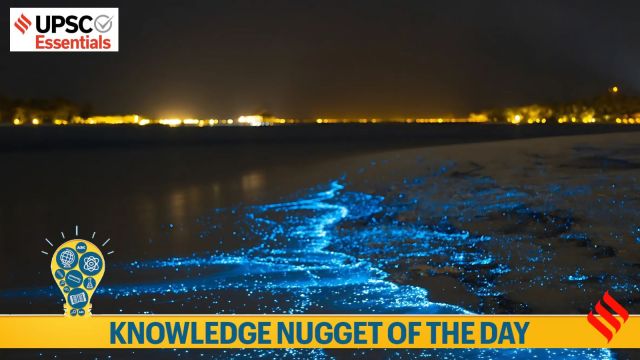Why in the news?
Recently, residents of Chennai witnessed a stunning phenomenon at the East Coast Road beach. Videos capturing the rare occurrence of blue bioluminescent waves quickly spread across social media, leaving viewers stunned.
Key Takeaways :
1. Bioluminescence is the property of a living organism to produce and emit light. This phenomena is rare in ecosystems on land, but it is common in the marine environment.
2. Many marine organisms such as bacteria, algae, jellyfish, worms, crustaceans, sea stars, fish and sharks, are able to produce their own light. Luminescence is generally higher in deep-living and planktonic organisms than in shallow species. Also, the appearance of bioluminescent light differs, depending on the habitat and organism in which it is found.
3. According to NOAA, Bioluminescence is the result of an enzymatic reaction. An enzyme speeds up the chemical reaction by helping a substrate react. The enzyme is reused in the reaction instead of being transformed into another molecule.
Story continues below this ad
4. The enzyme in bioluminescent reactions is luciferase. The different substrates are called luciferins. Luciferase helps catalyze the chemical reaction between the luciferins and oxygen. During this chemical reaction, the luciferin molecule is oxidized, which forms light and a new molecule, oxyluciferin, which is inactive.
 Learn through Image: Bioluminescence chemical reaction. (Source: NOAA)
Learn through Image: Bioluminescence chemical reaction. (Source: NOAA)
5. After the chemical reaction, luciferase is recycled, which means it can continue to produce light in the form of bioluminescence so long as both luciferin and oxygen are present.
6. The functions of bioluminescence have yet to be discovered. However, according to the National Ocean Service, sea creatures typically use bioluminescence to warn or evade predators, lure or detect prey, and communicate between members of the same species. Another explanation is that bioluminescence helps these organisms gather together and make colonies.
 Bioluminscence is caused by bright plankton that illuminates the water body. (Photo: Shutterstock)
Bioluminscence is caused by bright plankton that illuminates the water body. (Photo: Shutterstock)
7. According to marine experts, the phenomenon is an indicator of climate change and can have an impact on deep sea fishing. Factors such as the pattern of the wind and the temperature of the ocean also determine the occurrence of bioluminescent waves.
Story continues below this ad
8. Bioluminescence is not common in India. However, there are several tourist places across the world which are famous for the phenomenon. The Blue Grotto in Malta is one of nine caves near the island of Filfa that produces a phosphorescent glow. Similar to the Blue Grotto is Bioluminescent Bay in Puerto Rico, San Diego in California, Navarre Beach in Florida, and Toyama Bay in Japan.
BEYOND THE NUGGET: Bioluminescent mushrooms
9. According to a report by ONmanorama, in the forests of Kasaragod, researchers have discovered a rare species of bioluminescent mushrooms that emit a green light at night.
10. These fungi, scientifically known as Filoboletus manipularis, are capable of producing their own light through a biochemical process.
11. Filoboletus manipularis thrive in tropical, humid environments, typically found in dense forests where there’s plenty of decaying organic matter, like fallen trees and leaves. This rich, moist environment provides the nutrients and conditions necessary for their growth and their unique glowing property.
Story continues below this ad
12. Filoboletus manipularis emit a green light due to a chemical reaction involving luciferin (a pigment) and luciferase (an enzyme), with oxygen playing a critical role. This reaction produces light, a trait shared with other bioluminescent organisms like fireflies and certain marine creatures.
 Filoboletus manipularis is a fascinating species of bioluminescent mushroom. (Source: Freepik)
Filoboletus manipularis is a fascinating species of bioluminescent mushroom. (Source: Freepik)
13. While Filoboletus manipularis might look magical with its glowing green light, scientists strongly advise against consuming them. As many wild mushrooms contain toxins that can be harmful, and bioluminescent ones are no exception. The chemicals that make them glow could be toxic.
(Sources: What explains the ‘blue tide’, Bioluminescent mushrooms in Kasaragod, oceanexplorer.noaa.gov)
For your queries and suggestions write at roshni.yadav@indianexpress.com
Story continues below this ad
Subscribe to our UPSC newsletter and stay updated with the news cues from the past week.
Stay updated with the latest UPSC articles by joining our Telegram channel – Indian Express UPSC Hub, and follow us on Instagram and X.




 Bioluminscence is caused by bright plankton that illuminates the water body. (Photo: Shutterstock)
Bioluminscence is caused by bright plankton that illuminates the water body. (Photo: Shutterstock) Filoboletus manipularis is a fascinating species of bioluminescent mushroom. (Source: Freepik)
Filoboletus manipularis is a fascinating species of bioluminescent mushroom. (Source: Freepik)






























